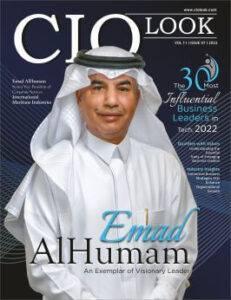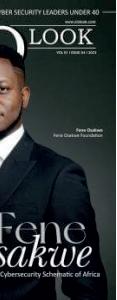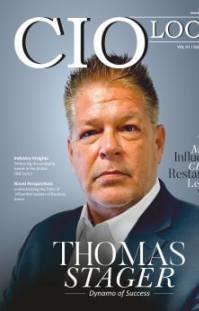












Inthe21stcentury,educationandtechnologyhave
becomedeeplyinterconnected,servingaspowerful forcesshapingthefutureoflearning.Technologyis nolongerasupplementarytoolintheclassroom;ithas becomeatransformativecatalystthatredefineshow knowledgeisdelivered,absorbed,andapplied. Innovationssuchasinteractivedigitalplatforms,artificial intelligence,anddata-drivenlearningsystemsare reshapingtraditionaleducation,makingitmore personalized,accessible,anddynamic.Atthecoreofthis transformationisashiftintheroleofeducators.Rather thansimplytransmittinginformation,theyarenow guidinginquiry,fosteringcreativity,andencouraging innovation.RichardLarsonexemplifiesthisshift.His pioneeringcontributionstoeducation,research,and interdisciplinarycollaborationhighlightthelastingimpact thatvisionaryeducatorscanhaveonbothindividualsand societyasawhole.
CIOLookinitsrecenteditiontitledTheGlobalIconin QuantitativeManagementandTechnology-Driven Teaching–2025featuresLarson’sdistinguishedcareeras acompellingtestamenttothetransformativepowerof education.ArenownedprofessorattheMassachusetts

InstituteofTechnology(MIT)foroverfivedecades, Larsonhasbeenasteadfastadvocateforeducationasa catalystforempowerment,innovation,andsocial advancement.Withafoundationalbackgroundinelectrical engineering,Larsonadoptedaninterdisciplinaryapproach, effectivelybridgingdiversefieldsandapplyingoperations researchtoaddresscriticalglobalchallengessuchasurban infrastructure,disasterresponse,andpublichealth.His teachingphilosophycentersonactivestudentengagement, mentorship,andfosteringcriticalthinkingandresilience.
Beyondtheclassroom,Larsonhasservedinpivotal leadershiproleswithinprominentprofessional organizations,includingORSAandINFORMS. Throughouthiscareer,Larsonhasauthoredover175 scientificpublicationsandsixbooks.Hiscontributions havebeenrecognizedwithnumerousaccolades,including theprestigiousLanchesterPrizeandtheLawrenceM. KleinAward.Perhapsmostsignificantly,hehasinspired generationsofstudentswhonowholdleadershiproles acrossacademia,government,andindustry.Larson’s enduringlegacyisoneofcommitment,innovation,and profoundimpactthrougheducation.
Haveagreatreadahead!



Lifelong Commitment to Educational Excellence
From Research to Results Empowering Students with AI-Powered Learning Tools
16 22 A R T I C L E S
From Financial Markets to Healthcare Analy�cs The Future of Quan�ta�ve Analysis in Data Science
PoojaMBansal Editor-in-Chief
CONTENT
Deputy Editor Anish Miller
Managing Editor Prince Bolton

FOLLOWUSON WE ARE ALSO AVAILABLE ON
www facebook.com/ciolook/ www.x.com/ciolookmagazine
DESIGN
Visualizer Dave Bates
Art & Design Director Davis Mar�n
Associate Designer Jameson Carl
SALES
Senior Sales Manager Wilson T., Hunter D.
Customer Success Manager Nelson M.
Sales Execu�ves Tim, Smith
TECHNICAL
Technical Head Peter Hayden
Technical Consultant Victor Collins July,
Research Analyst Eric Smith
SEO Execu�ve Alen Spencer
CONTACTUSON
Email info@ciolook com
For Subscrip�on www.ciolookmedia.com
Copyright © 2025 CIOLOOK, All rights reserved. The content and images used in this magazine should not be reproduced or transmi�ed in any form or by any means, electronic, mechanical, photocopying, recording or otherwise, without prior permission from CIOLOOK. Reprint rights remain solely with CIOLOOK.




“Richard Larson doesn’t seek to be remembered merely for his titles or accolades. Instead, he wants to be known as someone who loved his work, who genuinely valued his students, and who made meaningful contributions to the field of Operations Research and education.”
Richard Lasrson MIT Professor
Educationismorethanthetransmissionof knowledge;itisthekeytounlockinghuman potential,breakingsocialandeconomicbarriers, andbuildingamoreequitablesociety Aroundtheglobe, educationcontinuestoshapenotjustminds,butfutures.It empowersindividualstoovercomeadversity,fosters innovation,andpavesthewayforbothpersonaland nationaldevelopment.Inthe21stcentury,educationhas becomethemostpowerfulweapontofightinequality, poverty,andignorance.
Buteducationneedsmorethanclassroomsand curriculum—itneedspassionatementorswhocanguide learnersthroughthecomplexmazeofideasand possibilities.Teacherswhonotonlyteachbutinspire. Educatorswhotreateachstudentasafuturethinker, creator,andleader.Therightmentorcantransformthe classroomfromastaticlearningenvironmentintoa dynamicstageofdiscovery
OnesuchmentorisDr.RichardLarson,anAmerican engineerandoperationsresearchspecialistwhohasleftan indeliblemarkoneducationoverthepast55years.Asa professorattheMassachusettsInstituteofTechnology (MIT),Larsonhasdedicatedhislifetopushingacademic boundaries,mentoringstudents,andredefiningwhatit meanstobeavisionaryeducatorinmoderntimes.His journeyreflectstheveryessenceofwhatitmeanstobea changemakerineducation.
RichardLarsonwasborninBayside,Queens,NewYork Cityin1943.Hischildhoodjourneytookhimto PennsylvaniaandlatertoNorthPlainfield,NewJersey Theseearlymovesexposedhimtodiversecommunities, shapinghisworldviewatayoungage.However,itwas duringhisyearsatNeedhamHighSchoolinMassachusetts thatLarson'sacademicaspirationsbegantocrystallize.
“Professor Richard Larson’s long-standing role at MIT was not just about lecturing—it was about connecting, mentoring, and igniting curiosity.”
ThroughouthistimeatMIT,Larsonchallengedthenorm. Ratherthanremainingconfinedtoonedepartment,he becameknownforhisinterdisciplinaryapproach,teaching infivedifferentacademicdepartments,including electricalengineeringandtheInstituteforData,Systems, andSociety(IDSS).Thisflexibilityallowedhimtobridge traditionalacademicgapsandapplyresearchinreal-world, actionableways.
InLarson’swords,thegoalwasn’tjusttospecializebutto "buildbridgesacrossdisciplines."Hisworkinoperations researchspannedavastrangeofareas:fromurbanservice systemsandlogisticstodisasterplanning,pandemics, andsmart-energyhomes.Hiseffortsexemplifyhow academia,whenappliedthoughtfully,canservesocietyat large.
Aftergraduatinghighschool,hepursuedhighereducation atMIT,completinghisBachelor’s,Master’s,andPh.D.in ElectricalEngineering Whilemanystudentsstruggleto findtheirfooting,Richarddiscoveredapassionforphysics earlyon.Althoughhefoundchemistryuninspiringand biologyoverlyreliantonmemorization,physicssparked curiosityandpurpose.Heenvisionedhisfuturenotasa traditionalphysicistconfinedbyrigidacademic"silos,"but assomeonewhowouldtransitionfluidlyacross disciplines—seekinginnovationthroughcollaboration.
ProfessorRichardLarson’slong-standingroleatMITwas notjustaboutlecturing—itwasaboutconnecting, mentoring,andignitingcuriosity.Startinghiscareerasa youngstudentfromNeedham,just30minutesfromMIT, hevividlyrecallsthedayhereceivedhisacceptanceletter Convinceditwasamistake,heexperiencedwhathelater learnedwasacommonemotionalphenomenonamongnew MITadmits,humorouslytermedthe“GrouchoMarx Syndrome.”
Yetthatmomentmarkedthebeginningofajourneythat wouldnotonlychangehislifebutalsoinfluencethousands ofstudents.Larsonbelievesthateducationisaninvestment The



likenoother.It’snotatangibleasset,butit’sonethatno onecantakeawayfromyou.Helikenseducationtoa ladder—onethatliftsyoutowardnew,excitingdestinations witheverystep.
Throughouthiscareer,RichardLarson’simpactonstudents hasbeenprofound.Herecallsamomentwhenastruggling studentcametohisoffice,disheartenedafterreceivinga lowexamgrade.Ratherthanallowingthestudenttodrop thecourse,Larsontooktimetolisten,advise,andguidethe studentwithunwaveringencouragement.Eventually,that samestudentturnedthingsaroundandfinishedtheclass withtopgrades.
Suchstoriesaren'trareinLarson'scareer—theyarethe norm,andtheyrepresentthehumansideofteaching.More thangradesorcredentials,Larsonvaluesthehuman connectionandgrowththathappenswhenstudentsare trulymentored.
RichardLarson’sinfluenceextendsbeyondtheclassroom. HeservedasthePresidentoftheOperationsResearch SocietyofAmerica(ORSA)from1993to1994andlater asthePastPresidentofINFORMS(Institutefor OperationsResearchandtheManagementSciences)in 2005.Forover15years,healsoco-directedtheMIT OperationsResearchCenter,helpingshapethenext generationofproblemsolversandcriticalthinkers.
Hisextensiveresearchhasproducedover175scientific papersandsixbooks,eachcontributingtoabetter understandingofsystemsdesign,emergencyresponse,and educationreform.Amonghismostimpactfulinitiativesis theMITBLOSSOMS(BlendedLearningOpenSource ScienceorMathStudies),whichbringsengagingvideo lessonsinSTEMtostudentsaroundtheworld—particularly inunderservedareas.
EvenduringtheCOVID-19pandemic,Larsonstayedatthe forefrontofresearch,analyzingvaccinedistributionmodels andevaluatingstructuralweaknessesintheU.S. educationsystem.Hecontinuestopushboundaries, advocatingfortheroleofOperationsResearch(OR)in navigatingcomplexchallenges,fromhealthcrisesto economicdisruptions

“Dr. Richard Larson is not just a scholar or a teacher—he is a beacon of excellence in modern education.”


“Richard’s journey reflects the very essence of what it means to be a changemaker in education.”
LarsonfrequentlydescribesORas“theworld’smost importantinvisibleprofession,”asentimentechoedby howitsilentlysupportsmodernlife—fromtransportation systemstohospitalmanagement.
Nomatterthechangesintechnology,curriculum,or deliveryplatforms,onethinghasremainedconstantin ProfessorLarson’steachingphilosophy:student engagement.Hebelievesinmakingstudentsparticipants ratherthanpassiverecipients.Whetherthroughrelatable real-lifeexampleslikeairlineschedulingorqueue management,Larsonensureshisclassesremainvibrant andrelevant.
Hisuniquestyleofconnectingtheorywithpracticehas helpeddemystifycomplextopicsandmakethemaccessible toall,regardlessofbackgroundordiscipline.
Whenaskedtodefineavisionaryleader,RichardLarson highlightstraitsnotoftenfoundinconventionalacademic frameworks.Forhim,it’snotjustaboutsubjectmatter expertise.Atruevisionarymentorraisescriticalthinkers, encouragesindependentquestioning,andresiststheherd mentality Theylightthepathforothers—evenifthatpath isnew,uncertain,orcontroversial.
AccordingtoLarson,suchleadersgivetheirstudentsthe couragetobeoriginal,thewisdomtothinkdeeply,andthe resiliencetofacefailureandtryagain.
RichardLarsondoesn’tseektoberememberedmerelyfor histitlesoraccolades.Instead,hewantstobeknownas
someonewholovedhiswork,whogenuinelyvaluedhis students,andwhomademeaningfulcontributionstothe fieldofOperationsResearchandeducation.Hehopeshis studentsrememberhimassomeonewhohelpedthem dreambigger,aimhigher,andpushboundaries.
Hisgraduatestudentshavegoneontosuccessfulcareersin academia,government,andindustry,carryinghis mentorshipintotheirownspheresofinfluence.
Throughouthisstellarcareer,ProfessorLarsonhasreceived numerousawardsandhonors.Hisfirstbook,“Urban PolicePatrolAnalysis”(MITPress,1972)wonthe LanchesterPrize.Hispapers,co-authoredwithstudents, suchas“ModelingtheEffectsofH1N1InfluenzaVaccine DistributionintheU.S.”and“STEMCrisisorSTEM Surplus?YesandYes”wonbestpaperawardsandwere featuredinmajorpublications.
In2015,theLawrenceM.KleinAwardfromtheU.S. DepartmentofLaboraddedanothermilestonetohis distinguishedcareer.RecognitionfromtheNewYork Timesandseveralglobaljournalsfurtherunderscorethe relevanceandimpactofhiswork.
Dr.RichardLarsonisnotjustascholarorateacher—heis abeaconofexcellenceinmoderneducation.Hisabilityto blendresearch,mentorship,interdisciplinaryinnovation, andpassionintooneremarkablejourneymakeshimatrue rolemodelforcurrentandfutureeducators.
Hisstoryillustrateswhathappenswhenabrilliantmind commitsitselfnotjusttoknowledge,buttoservice, growth,andthebettermentofothers.FromNewYorkto MIT,andfromayoungdreamertoaglobalthoughtleader, RichardLarsonhaslivedalifethatembodiesthepurest essenceofeducation:toempower,toinspire,andto uplift.


Artificial intelligence (AI) is revolutionizing the learning and teaching landscape through its application in schools. With the evolution of technology,AI-basedlearningtoolshavealsoevolved,offering learners customized, efficient, and engaging learning spaces. Apartfromcomplementingtraditionalclassroomlearning,the tools also make learners independent learners Through the incorporationofAI,teachersandinstitutionscandesignmore inclusive and responsive learning environments that adapt to learners'diversity.Artificialintelligencelearningisarealityand not a fantasy to be seen only in schools and higher learning institutions worldwide. Intelligent tutoring systems and adaptive testing to AI-enabled content creation and learning analyticsarealltechnologieswhoseaimistoenhancestudent performance Sincethedigitalnativesareincreasinglygetting accustomed to smart technologies, integrating AI in their learningmakesitmorenatural,engaging,andefficient.
ProposalforPersonalizedLearningExperience
Perhaps the greatest advantage of AI-facilitated learning solutions is that it has the potential to provide personalized learning experiences Unlike conventional teaching approaches,whicharemorelikeaone-size-fits-allapproach,AI can read individual students' data learning speed, strengths, weaknesses,andinterests totailoraccordingly.Platformslike Khan Academy, Duolingo, and Squirrel AI use adaptive technologies that change lesson plans in the moment so the student is receiving material not too easy or too hard The personalization relates to the student, encourages the student, and enables the new, nuanced concepts to be more easily absorbed AIcanalsoprovidefeedbackandsupportinrealtime suchthatthestudentcanlearnaccordingtohisorherownspeed withoutevenwaitingfortheinstructortorespond.
For instance, intelligent tutoring systems like Carnegie Learning's MATHia replicate the assistance of a tutor, giving
cues,explanation,andencouragementtostudentsastheywork through exercises. These systems are capable of identifying learning gaps early on and recommending remedial content, reducing frustration and increasing learner confidence Students not only score better in academics but also assume greaterresponsibilityfortheirownlearningexperienceaswell ThepersonalizationofferedbyAIgoesmuchbeyondacademic content, as well. Emotional intelligence code is capable of determining the mood and engagement level of a student and enabling tools to tailor the tone, level of difficulty, or rate of contentpresentation
AI technology can also make learning more inclusive and accessible. Learning can be difficult for disabled students or onesthathavelanguageproblemsinthetraditionalclassroom. AItechnologybridgessuchgapsbyintegratingcapabilitieslike speech-to-text,text-to-speech,languagetranslation,andimage recognition Tools like Microsoft's Immersive Reader and Google'sRead\\&Writeprovideadaptiveassistivetechnology, enabling dyslexic, ADHD, or visually impaired students to enjoybetterreadingandlearningmaterialaccess
Apart from that,AI also supports teachers in identifying and assistingstudentswhoarestrugglingmoreeffectively.Learning analyticssoftwarecantrackperformanceandbehaviormetrics andidentifytrendsthatarelikelytoindicatedisengagementor learning challenges. Early evidence-based intervention is enabledbywhichteacherscanprovidesupportattherighttime, either through individualized learning plans or individual support. This proactive approach not only supports improved academicoutcomesbutalsofostersamorejustclimateinwhich all students can flourish irrespective of learning difficulties or backgrounds AI also brings quality learning to remote and disadvantaged communities Where there is insufficient instructors or poor infrastructure threatening learning, AI technology can serve as virtual classrooms and teaching staff andgivestudentsachancetoaccesslearning.
AItechnologyempowersself-directedlearners,acquiringvital skills that transcend the classroom AI-facilitated education toolsandappsallowstudentstostudytheirchosentopics,hone theirtalent,andtracktheirprogressindependentlyofongoing surveillance Self-directedlearningisthekeycompetenceinthe present-day knowledge economy. Quizlet, Coursera, and edX useAItosuggestsubjectsandstudymaterialsothatlearnerscan browsevastdigitalrepositorieswithminimaleffort.
With improving technology and new qualifications emerging, AI-powered tools can help people upskill and reskill on an adaptive and customized level For example, artificial intelligence-powered career guidance tools identify users' abilities and recommend areas of study that align with their professional goals. With it, AI enables the development of responsive,educatedlearnerstokeepupwithchangingneeds andgainpotentialbenefitsthroughouttheirlifecycle AIhelps developsoftskillssuchasproblem-solving,digitalliteracy,and timemanagementbyguidingthelearnersthroughassignments, suggesting good study habits, and encouraging reflective practice
The application of AI-powered learning technologies is a paradigmshiftinthedeliveryandexperienceofeducation AIpowered learning technologies personalize learning, provide equitable access, and center learning around the learner, rendering education more efficient and inclusive for every learner. Through the customization of instruction to learners, support for multiple learners, and fostering life-long learning potential,AIcouldtransformlearningresultsglobally.Butitis absolutely vital to ensure AI integration with foresight and ethical responsibility Data privacy, algorithmic fairness, and equalaccessareconcernsthatmustbetakenonsothatAIworks foreverystudent,notmerelyanadvantagedsubsetofstudents Teachers,policymakers,andtechnologistsmustworktogether tomakesystemsfair,transparent,andgroundedinpedagogy.












Quantitative analysis has always been a fundamental componentofdatascience,providingthemathematical precisionrequiredtoderiveinsights,makepredictions, and support informed decision-making across a wide range of industries Aswecontinuetomovedeeperintotheageofbigdata and artificial intelligence (AI), the scope and influence of quantitativeanalysisareexpanding.Newmethods,increasingly advancedalgorithms,andmorepowerfulcomputationaltoolsare transformingthewaysinwhichdataisinterpretedandapplied
This article outlines the future of quantitative analysis in data science, focusing on the integration of machine learning with traditional statistics, the shift toward real-time data processing, andtherisingemphasisoninterpretabilityandethics.
In the evolving landscape of data science, the combination of classical statistical techniques with modern machine learning models is becoming increasingly essential While machine learningisadeptatmanaginglarge-scaleandcomplexdatasets, traditional statistics contribute a level of transparency and theoretical grounding that many machine learning models currently lack. Emerging hybrid approaches, such as Bayesian neural networks, generalized additive models, and explainable artificial intelligence tools, are offering a balance between accuracyandinterpretability Thesetechniquesallowanalyststo make precise predictions while also gaining a clearer understanding of the variables and mechanisms driving those outcomes,whichiscrucialfortrustandaccountability in datadrivensystems.
As organizations become more reliant on data-informed strategies, the need for reliable inference methods continues to grow Traditional models like linear regression, time-series forecasting,andhypothesistestingarestillvaluable,buttheyare increasingly being adapted to work alongside more advanced
techniquessuchasensemblemethods,unsupervisedlearning,and deeplearning.Thisconvergenceofmethodologiesrequiresdata professionalstodevelopabroaderandmoreintegratedskillset Those who can effectively bridge the gap between theoretical statisticsandalgorithmicmodelingwillbewell-positionedtolead futureinnovationsinthefield
Thegrowthofreal-timedatasources,drivenbytechnologieslike the Internet of Things (IoT), edge computing, and streaming platforms, is reshaping the expectations placed on quantitative analysis In fields such as finance, logistics, cybersecurity, and healthcare,decision-makingmustoftenoccurwithinsecondsor evenmilliseconds Traditionalbatch-processingmethodsaretoo slowfortheseusecases.Thefutureofquantitativeanalysiswill emphasizemodelsthatarenotonlyaccuratebutalsocapableof operating efficiently in real time. Algorithms such as online learning, adaptive filters, and real-time anomaly detection are gaining prominence and are increasingly vital in fast-paced environments
With this shift comes a greater need for scalability and robust system design. Quantitative models must be integrated into operational systems that allow them to update continuously withouttheneedformanualretraining.TechnologieslikeApache Kafka,ApacheFlink,andvariouscloud-basedstreamprocessing platforms are making this integration possible However, the modelsthemselvesmustalsoevolvetoincludefeaturessuchas uncertainty estimation and dynamic recalibration Quantitative analysis is becoming a continuous and iterative process rather thanastaticone.
Asthecapabilitiesofdatasciencecontinuetoexpand,sotoodo theethicalresponsibilitiesthatcomewithapplyingquantitative analysis Oneoftheprimarychallengesisinterpretability Many machine learning models, particularly deep learning networks,
function as black boxes that offer little visibility into how they arriveattheirconclusions.Thislackoftransparencycanleadto reducedtrustandlimitedapplicabilityinhigh-stakesareassuchas healthcare, criminal justice, and finance The future of quantitativeanalysiswillrequiremodelstobenotonlyaccurate butalsounderstandable ToolssuchasSHAP(SHapleyAdditive Explanations) and LIME (Local Interpretable Model-agnostic Explanations)arealreadyhelpingtomakecomplexmodelsmore transparent.
Ethicalconcernsextendbeyondtransparencytoincludefairness andbias Quantitativemodelsareonlyasgoodasthedatatheyare trained on, and if that data contains historical inequalities or systemic biases, the resulting predictions may perpetuate those issues Futuredatascientistswillneedtoactivelyaddressthese concerns by implementing fairness metrics, conducting bias audits,andapplyingdebiasingtechniquesthroughoutthemodel developmentlifecycle.Additionally,thereisgrowingsupportfor regulatory oversight and ethical frameworks that guide the responsibleuseofdatascience Professionalsinthefieldwillneed to stay informed about these developments and be prepared to align their practices with emerging standards to ensure that quantitativeanalysisservesthebroadergoalsoffairnessand accountability.
Thefutureofquantitativeanalysisindatascienceischaracterized byadeeperintegrationofstatisticalandalgorithmicmethods,a shift toward real-time applications, and a heightened focus on ethical responsibility and transparency. As data becomes increasinglycentraltohowdecisionsaremade,theexpectations placedonanalystsandtheirmodelsarealsogrowing.Thosewho can combine strong quantitative foundations with modern computationalskillsandacommitmenttoethicalpracticeswillbe theleadersofthenextgenerationofdatascience Byadaptingto thesechangesandcontinuingtoinnovate,thefieldofquantitative analysis will remain a critical pillar of data science, driving insightsanddecisionsthatshapethefutureacrossindustries.





























































